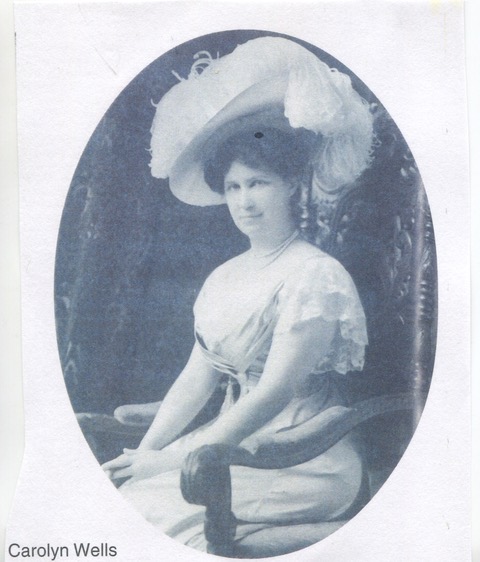
Carolyn Wells – “America’s Most Famous Mystery Writer”
Submitted by Al Shipley, City Historian and Rahway Library Research Consultant
During her lifetime, Rahway native Carolyn Wells (1862–1942) was hailed as “America’s Most Famous Mystery Writer” and was considered the authority on that genre. In a career spanning over forty years, Ms. Wells produced a body of more than one hundred and eighty literary works including novels, plays, and anthologies.
Born in Rahway, the daughter of New York insurance executive William Wells, she grew up in the elegant Victorian style home which still graces the corner of Elm and Esterbrook Avenues. From an early age she had a love for literature. After her graduation from Rahway High (Class of 1879), she became an assistant librarian at the Rahway Library and in 1890 was named head librarian, a position she held for twelve years. Surrounded by books, she eventually tried her hand at writing stories of her own and in 1896 published The Sign of the Sphinx, a collection of verse riddles.
Over the next fourteen years Wells penned stories and poems geared mainly for young readers. Her early works featured playful poetry, nonsense verse, humor, and novels for children. Akin to the popular Bobbsey Twins series, she created the Patty Books, the Margorie Books and the Dick and Dolly series.
Wells’ career took a turn after 1910 when she became fascinated with the structure of the mystery story and ventured into the format, having a more sophisticated adult audience in mind. From 1910–1940 she wrote a succession of some seventy mystery novels and created her own detective character, a distinguished sleuth named Fleming Stone. In 1929 she wrote The Technique of the Mystery Story considered by aficionados of the field to be the “most understanding study of the mystery form produced up to that time.”
During her career, she also wrote and generated ideas for 16 silent films and several Broadway shows, edited the first literary daily, she was one of the first crossword puzzle editors for the New York Times, and was a founding member of the Authors League, the precursor to the Authors Guild.
In 1918 Ms. Wells married Hadwin Houghton, son of the wealthy book publisher Bernard Houghton and heir to the Houghton–Mifflin publishing empire and moved to New York City where she lived until her death. Although she loved the New York social scene, her years in Rahway held special memories as she related in her autobiography Rest of My Life (1937).
“Across the street from my home lived a Quaker gentleman with a large estate like an English Park. It pleased him to walk around his gardens at sunset and I often walked with him. He told me the names of his many rare trees and flowers.”
“When I married, I came to New York to live, which gratified a lifelong longing. Not that I didn’t love my New Jersey home with its broad lawns, big trees, flower gardens and pleasant verandas.”
Ms. Wells died on March 26, 1942, and was brought back to her hometown to be interred in the Rahway Cemetery next to her husband. Her stately Elm Avenue home and her eclectic collection of books (the Rahway Public Library has over one hundred of her titles) keeps her connection to Rahway alive.
Carolyn Wells Biographer to Speak at Rahway Library
What ever happened to the story and legacy of Carolyn Wells? Why did the name of this highly accomplished writer of mystery novels become lost in time? How is she viewed by the critics of today? These questions and more will be addressed on Wednesday evening, March 13, when Rebecca Rego Barry, author of a newly published biography, The Vanishing of Carolyn Wells: Investigations into a forgotten Mystery Author, presents a discussion at the Rahway Library. The program will begin at 5:00 p.m. Copies of the book will be available for purchase.
Ms. Barry, an established author, magazine editor, journalist, and bibliophile, had made several trips to the Rahway Library during her research to search through the materials stored in the Rahway History Room.
The Rahway Library is one stop on Ms. Barry’s book tour which includes programs at Ohio State University (virtual), the New York International Antiquarian Book Fair, and the University of Delaware.
